A relatively simple 1000 watt pure sine wave inverter circuit is explained here using a signal amplifier and a power transformer.
As can be seen in the first diagram below, the configuration is a simple mosfet based designed for amplifying current at +/-60 volts such that the connected transformer corresponds to generate the required 1kva output.
UPDATE:
There's a much easier and efficient way of making a 1 kva inverter circuit using the following 4017 PWM version circuit. Since the PWM is created directly through the 4017 output, the PWMs are much accurate and the waveform is uniform and does not depend on any external adjustments.
The biggest advantage of using this circuit is that the output can be modified to almost a pure sine wave by adding a few PPC capacitors across the transformer output.
Here' the circuit which you can try:

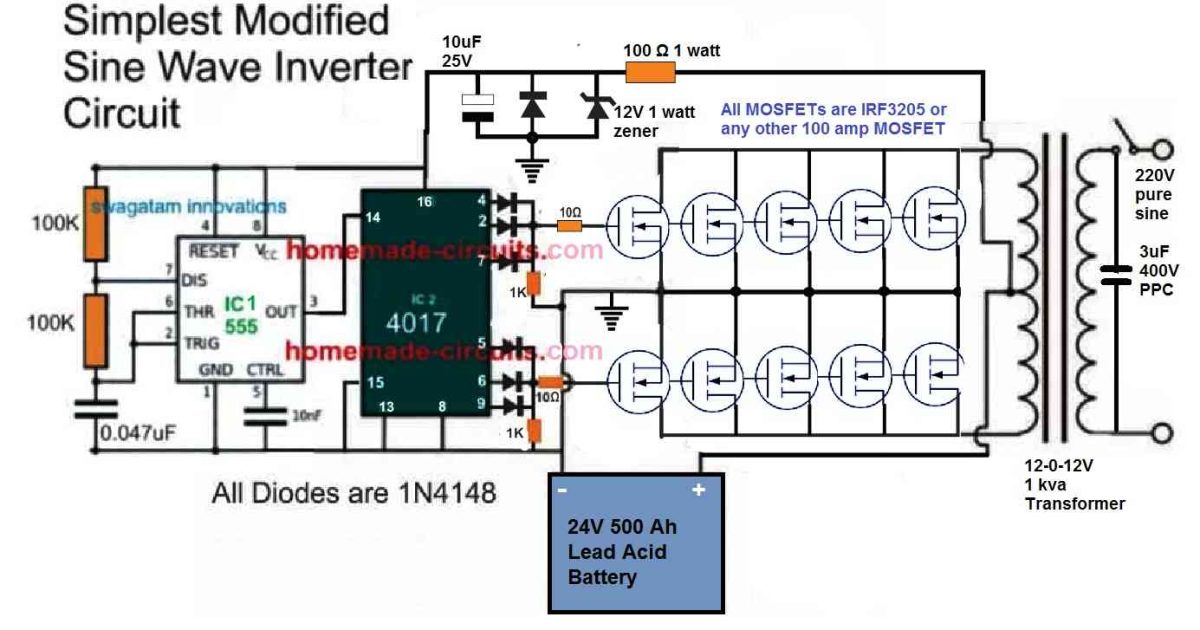
Parts List
- Resistors
- All resistors are 1/4 watt 5% unless specified
- 100K = 2nos
- 100 ohm 1 watt = 1no
- 1K = 2no
- 10 ohm = 2no
- Capacitors
- 0.047uF ceramic or PPC = 1no
- 10nF ceramic or PPC = 1no
- 10uF/25V Electrolytic = 1no
- Semiconductors
- 1N4148 diodes = 7nos
- 12V/1 watt zener diode = 1no
- IRF3205 MOSFETs = 10nos
- Transformer 12-0-12V/220V/1kva
- Battery = 24V/500 Ah = 1no
The previous original article which is continued in the following paragraphs also discusses a 1000 watt inverter circuit, however, this circuit being a linear amplifier is not so efficient, and may result in a lot of dissipation.
I would recommend trying the above circuit, which will give you a 100% results quickly.
Remember, you must first try and confirm the working of the inverter using single MOSFETs on each channel. Once the working is confirmed then you can add more number of MOSFETs in parallel to upgrade the power capacity of the inverter to 1000 watts
Circuit Operation
Q1, Q2 forms the initial differential amplifier stage which appropriately raises the 1vpp sine signal at its input to a level which becomes suitable for initiating the driver stage made up of Q3, Q4, Q5.
This stage further raises the voltage such that it becomes sufficient for driving the mosfets.
The mosfets are also formed in the push pull format, which effectively shuffles the entire 60 volts across the transformer windings 50 times per second such that the output of the transformer generates the intended 1000 watts AC at the mains level.
Each pair is responsible for handling 100 watts of output, together all the 10 pairs dump 1000 watts into the transformer.
For acquiring the intended pure sine wave output, a suitable sine input is required which is fulfilled with the help of a simple sine wave generator circuit.
It is made up of a couple of opamps and a few other passive parts. It must be operated with voltages between 5 and 12. This voltage should be suitably derived from one of the batteries which are being incorporated for driving the inverter circuit.
The inverter is driven with voltages of +/-60 volts that amounts to 120 V DC.
This huge voltage level is obtained by putting 10 nos. of 12 volt batteries in series.
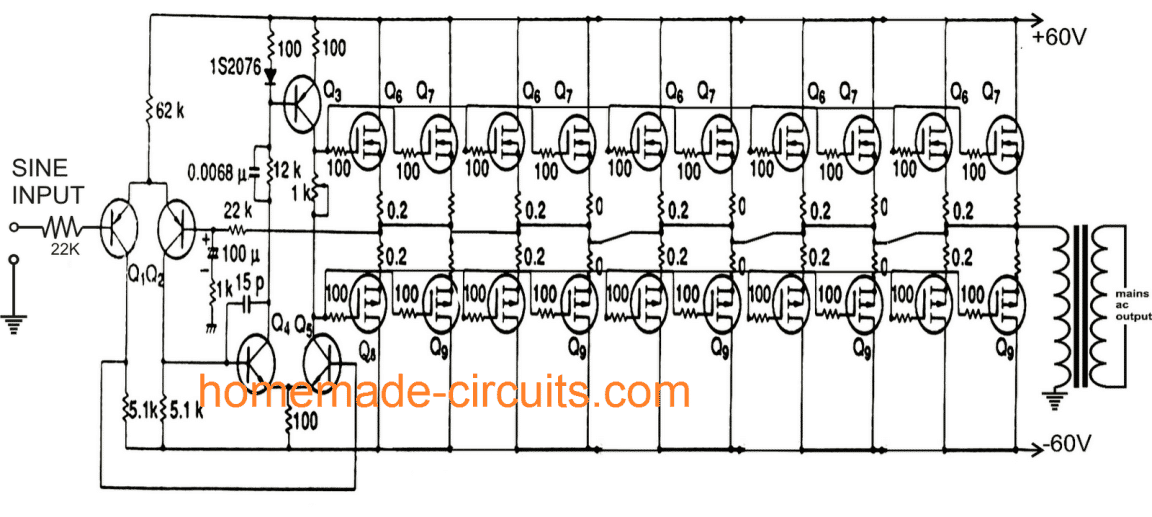
The Sinewave Generator Circuit
The below given diagram shows a simple sine wave generator circuit which may be used for driving the above inverter circuit, however since the output from this generator is exponential by nature, might cause a lot of heating of the mosfets.
A better option would be to incorporate a PWM based circuit which would supply the above circuit with appropriately optimized PWM pulses equivalent to a standard sine signal.
The PWM circuit utilizing the IC555 has also been referred in the next diagram, which may be used for triggering the above 1000 watt inverter circuit.
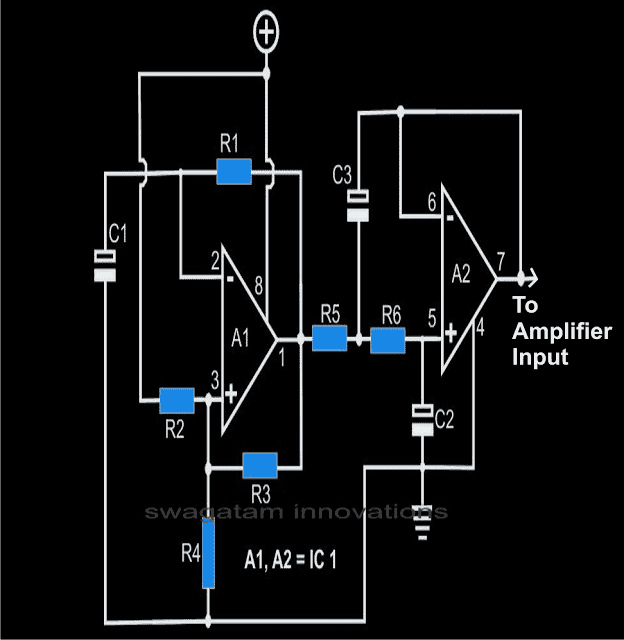
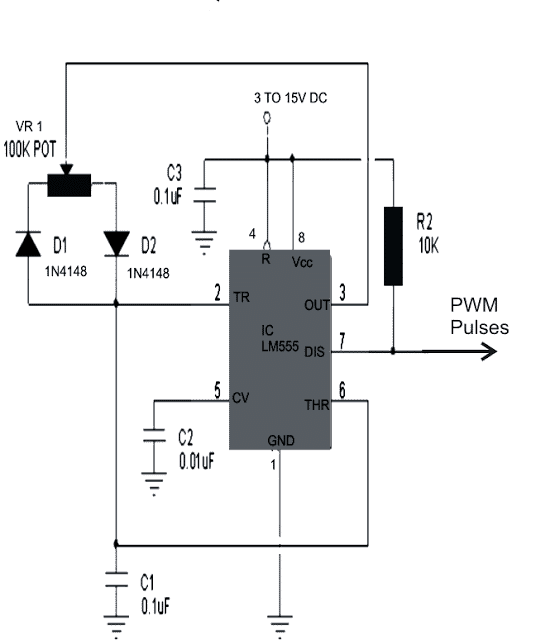
Parts List for the sine generator circuit
All resistors are 1/8 watts, 1%, MFR
R1 = 14K3 (12K1 for 60Hz),
R2, R3, R4, R7, R8 = 1K,
R5, R6 = 2K2 (1K9 for 60Hz),
R9 = 20K
C1, C2 = 1µF, TANT.
C3 = 2µF, TANT (TWO 1µF IN PARALLEL)
C4, C6, C7 = 2µ2/25V,
C5 = 100µ/50v,
C8 = 22µF/25V
A1, A2 = TL 072
Part List for Inverter
Q1, Q2 = BC556
Q3 = BD140
Q4, Q5 = BD139
All N-channel mosfet are = K1058
All P-channel mosfets are = J162
Transformer = 0-60V/1000 watts/output 110/220volts 50Hz/60Hz
The proposed 1 kva inverter discussed in the above sections can be much streamlined and reduced in size as given in the following design:
How to Connect Batteries
The diagram also shows the method of connecting the battery, and the supply connections for the sine wave or the PWM oscillator stages.
Here just four mosfets have been used which could be IRF4905 for the p-channel, and IRF2907 for n-channel.
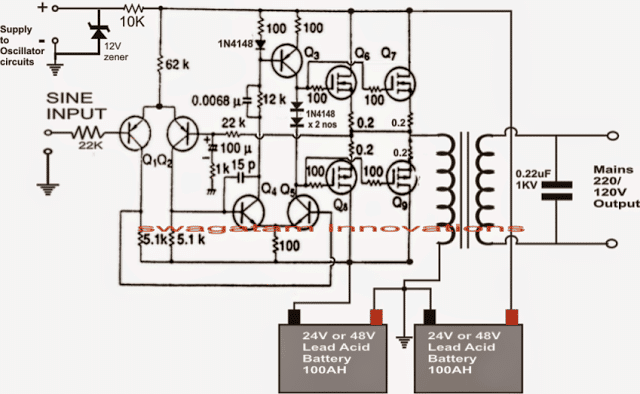
Complete 1 kva inverter circuit design with 50 Hz sine oscillator
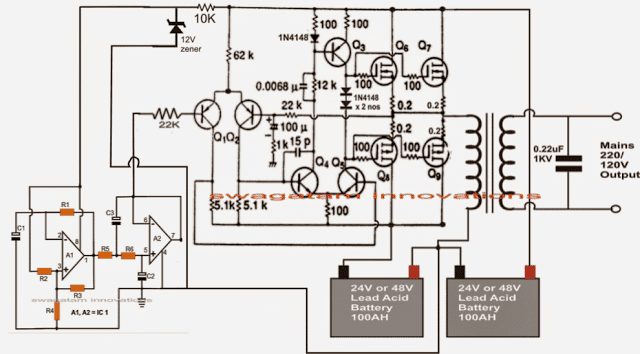
In the above section we have learned a full bridge design in which two batteries are involved for accomplishing the required 1kva output. Now let's investigate how a full bridge design could be constructed using 4 N channel mosfet and using a single battery.
The following section shows how a full-bridge 1 KVA inverter circuit can be built using, without incorporating complicated high side driver networks or chips.
Using Arduino
The above explained 1kva sinewave inverter circuit can be also driven through an Arduino for achieving almost a prefect sinewave output.
The complete Arduino based circuit diagram can be seen below:
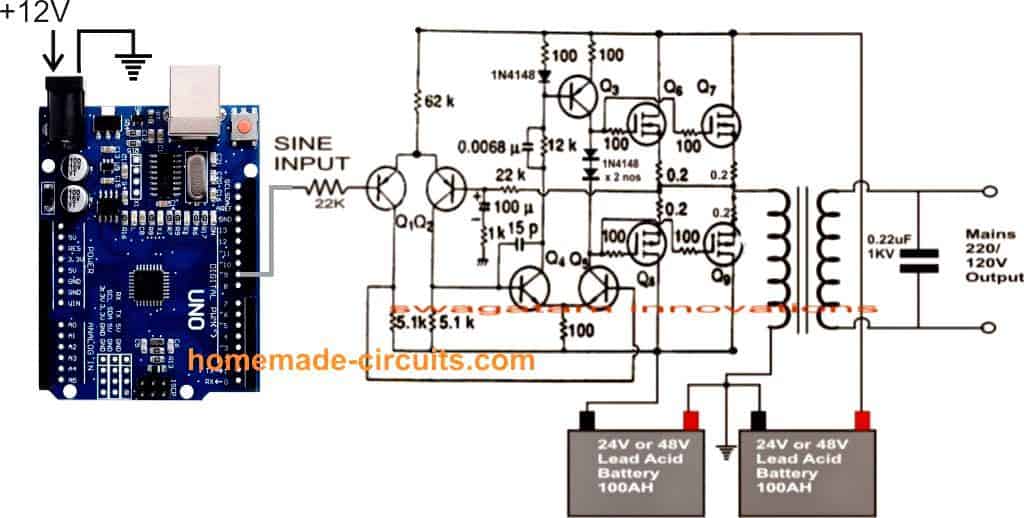
Program Code is given below:
//code modified for improvement from http://forum.arduino.cc/index.php?topic=8563.0
//connect pin 9 -> 10k Ohm + (series with)100nF ceramic cap -> GND, tap the sinewave signal from the point at between the resistor and cap.
float wav1[3];//0 frequency, 1 unscaled amplitude, 2 is final amplitude
int average;
const int Pin = 9;
float time;
float percentage;
float templitude;
float offset = 2.5; // default value 2.5 volt as operating range voltage is 0~5V
float minOutputScale = 0.0;
float maxOutputScale = 5.0;
const int resolution = 1; //this determines the update speed. A lower number means a higher refresh rate.
const float pi = 3.14159;
void setup() {
wav1[0] = 50; //frequency of the sine wave
wav1[1] = 2.5; // 0V - 2.5V amplitude (Max amplitude + offset) value must not exceed the "maxOutputScale"
TCCR1B = TCCR1B & 0b11111000 | 1;//set timer 1B (pin 9) to 31250khz
pinMode(Pin, OUTPUT);
//Serial.begin(115200);//this is for debugging
}
void loop() {
time = micros()% 1000000;
percentage = time / 1000000;
templitude = sin(((percentage) * wav1[0]) * 2 * pi);
wav1[2] = (templitude * wav1[1]) + offset; //shift the origin of sinewave with offset.
average = mapf(wav1[2],minOutputScale,maxOutputScale,0,255);
analogWrite(9, average);//set output "voltage"
delayMicroseconds(resolution);//this is to give the micro time to set the "voltage"
}
// function to map float number with integer scale - courtesy of other developers.
long mapf(float x, float in_min, float in_max, long out_min, long out_max)
{
return (x - in_min) * (out_max - out_min) / (in_max - in_min) + out_min;
}
The Full-Bridge Inverter Concept
Driving a full bridge mosfet network having 4 N-channel mosfets is never easy, rather it calls for reasonably complex circuitry involving complex high side driver networks.
If you study the following circuit which has been developed by me, you will discover that after all it's not that difficult to design such networks and can be done even with ordinary components.
We will study the concept with the help of the shown circuit diagram which is in the form of a modified 1 kva inverter circuit employing 4 N-channel mosfets.
As we all know, when 4 N-channel mosfets are involved in an H-bridge network, a bootstrapping network becomes imperative for driving the high side or the upper two mosfets whose drains are connected to the high side or the battery (+) or the positive of the given supply.
In the proposed design, the bootstrapping network is formed with the help of six NOT gates and a few other passive components.
The output of the NOT gates which are configured as buffers generate voltage twice that of the supply range, meaning if the supply is 12V, the NOT gate outputs generate around 22V.
This stepped up voltage is applied to the gates of the high side mosfets via the emitter pinouts of two respective NPN transistors.
Since these transistors must be switched in such a way that diagonally opposite mosfets conduct at a time while the the diagonally paired mosfets at the two arms of the bridge conduct alternately.
This function is effectively handled by the sequential output high generator IC 4017, which is technically called Johnson divide by 10 counter/divider IC.
The Bootstrapping Network
The driving frequency for the above IC is derived from the bootstrapping network itself just to avoid the need of an external oscillator stage.
The frequency of the bootstrapping network should be adjusted such that the output frequency of the transformer gets optimized to the required degree of 50 or 60 Hz, as per the required specs.
While sequencing, the outputs of the IC 4017 trigger the connected mosfets appropriately producing the required push-pull effect on the attached transformer winding which activates the inverter functioning.
The PNP transistor which can be witnessed attached with the NPN transistors make sure that the gate capacitance of the mosfets are effectively discharged in the course of the action for enabling efficient functioning of the entire system.
The pinout connections to the mosfets can be altered and changed as per individual preferences, this might also require the involvement of the reset pin#15 connection.
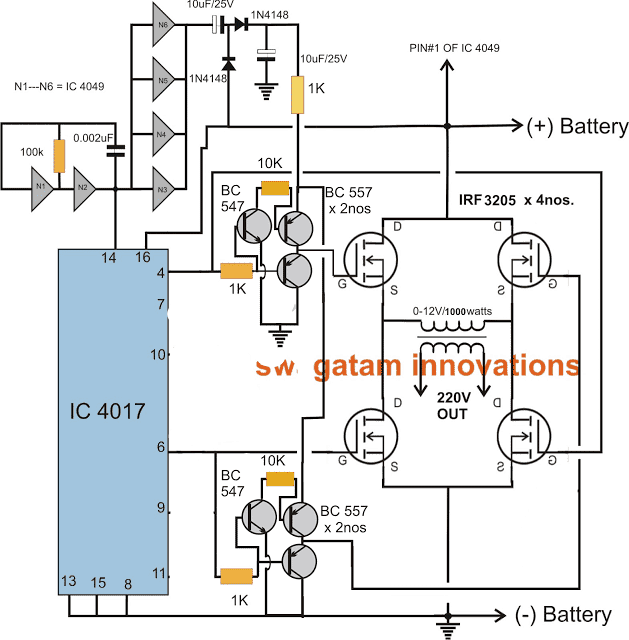
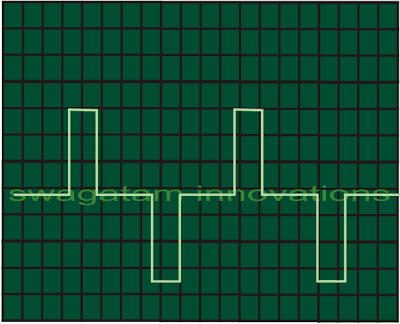
Waveform Images
The above design was tested and verified by Mr. Robin Peter one of the avid hobbyists and contributor to this blog, the following waveform images were recorded by him during the testing process.





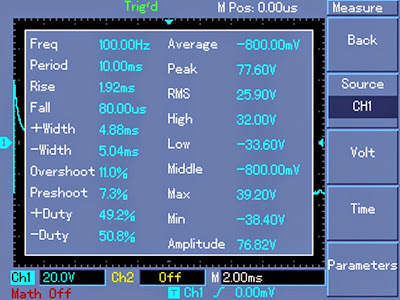

Have Questions? Please Leave a Comment. I have answered over 50,000. Kindly ensure the comments are related to the above topic.
for how long can it run using 24v?
can it run refrigerator and TV set at same time?
kindly help me with diagram that use mosfet 1010
To run a TV set and a refrigerator together, you might need to upgrade inverter design to 2000 watts minimum.
dear, friend I want making a Solar invertor 5 Kw 24 volt without battery. Please help me thanks,
Hello Abdul, with 24V, your solar panel will need to be rated at 5000/24 = 208 amps, which looks impracticable…
Hello! I know I’d already asked this circuit or subject 7 months ago but I revisited it today and I would to like ask again. The second circuit diagram that using sine generator circuit, is it pure sinewave circuit?
Yes, it is a pure sine wave inverter but the efficiency will be low due to high heat dissipation.
I’m interested buiding a power inverter and I like sinewave because of its nature that most elctronic devices it can be use. But on the other hand, I also read your modified sinewave 500 watts as well. Maybe I will just build latter first. In terms of effiecient, which is better the 1K sinewave or 500 watts modified?
Which 500 watt modified inverter are you referring to? Please provide the link of that article.
Can I use above H bridge ckt. for 24 v , 600Khz ?
I would recommend using the following circuit with the 4017 outputs, because it is much simpler.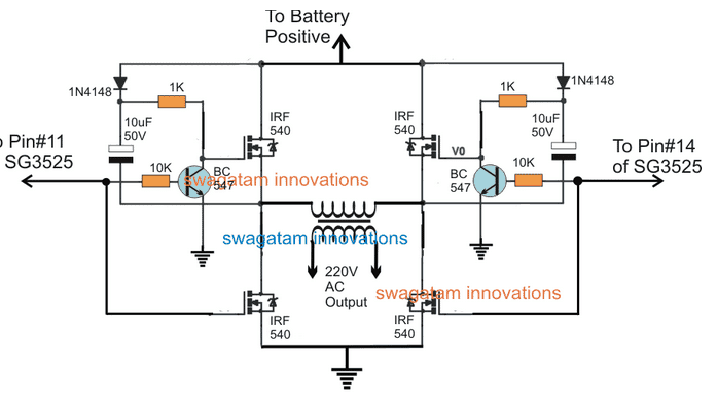
You can use 24V 600kHz with the above circuit.
Hey, I am new. In the Arduino based circuit diagram, I need only a 120 volt AC output. 220 is not required. What change can be done? Would really like to try this.
Hey Kerry, For 120V output you just have to use a transformer whose secondary winding is rated to produce 120V instead of 220V.
Thanks Swagatam. Do you know if there is a clearer drawing of the circuit somewhere?
No problem Kerry. I have an Arduino inverter article as given below. In this diagram you just have to replace the transformer with a 6-0-6V primary and 120V secondary winding. That’s all. If you this you will be able to get the required 120V from the inverter.
https://www.homemade-circuits.com/arduino-pure-sine-wave-inverter-circuit/
On the first schematic above. Is it modified sinewave or pure sinewave? cause on the diagram where in the transformer output there is “pure sinewave” written on it.
The first circuit will produce almost a pure sinewave AC once the 3uF output capacitor is connected.
Hello sir, i really appreciate the help you are rendering.
How can i use egs002 pure sine wave mosfet driver in the above circuit?
Hello Olusegun,
The EGS002 is itself a sine wave inverter module which can be configured with external mosfets for high power output. For the circuit diagram you can refer to the following article:
https://www.homemade-circuits.com/egs002-datasheet-circuit-diagram-explained/
Sir please. if I need any amount of power of my desire all I have to do is to keep increasing the BATTERY, the TRANSFORMER and RESISTOR Living the MOSFET the way it is ?
Yes that’s correct…but MOSFETs may also be required to be upgraded. However since the first design already has many high power mosfets connected in parallel, they won’t require an upgrade for 3000 watts.
Calculate Battery, Transformer, MOSFET in Inverter
With the diagram in this Article, it means it can take up to 3,000 watt without upgrading the recommended MOSFET already used in this Article… Is that correct?
I think you are referring to the IRF3205 msofets, yes that’s correct, if the mosfets are connected with large heatsinks and the battery voltage is around 48 V.
Sir please how can I increase the power to 3000w on the first diagram
Samuel, It can be done by using a 48 V 300 Ah battery, 24-0-24V 150 amp transformer. Change the 100 ohm 1 watt to 1K 2 watt
Thank you sir for answering my previous question Please can i use it to power my television and refrigerator.
Yes you can use it.
Sir please in that first article if I use 4 mosfet and 6v 50amp transformer with 12v 45ah can i get 1500watt
Hi John,
For getting 1500 watt a much bigger battery will be required. It should rated as follows:
1500 / 12 = 125 amps. 125 amps will be the discharge rate per hour. So if 5 hour back up is required, the battery will need to be 125 x 5 = 750 Ah
Can I use your circuit diagram to make same productions ?
Yes you can use them for production.
How many mosfets will I add in each channel to get 2kva at 12v/200ah battery
You can add 5 nos of IRF3205 on each channel
Hello Sir.
Good day,inverter will remain among the focus among your projects.i saw an Arnduino,5v dc to ac spwm board in an online retailer with 17 pins. I didnt know much about Arduino.My question is how can i inco-orperate it to an inverter circuit,,,that is pin connections..Is it good for me to use a 24v supply for the inverter and 5v for the Arduino board.
Another question is …these online cheap china inverters,are they good.Does their template match with their output.
Thank you so much.
Thank you Patrick,
You can feed the SPWM from the Arduino into the base of transistor drivers to drive the transformer with the SPWM.
Yes 24V is better than 12V since higher voltage means lower current which in turns helps to keep the transformer size smaller and generate lower amount of heat on the mosfets.
I have never used a Chinese inverter so I am not sure how good they are. You can confirm it only after a practical testing.
You can get more information regarding how to interface SPWM Arduino with transistors in the following link:
Arduino Pure Sine Wave Inverter Circuit with Full Program Code
Hello.
It’s a nice job! I like simple decisions of difficult task! I’m sorry, but I want to ask here you one stuff. Did you ever designed high power buck 220DC-120AC pure wave 60Hz? I’m working on this project for my home. I would like to get some fresh idea. If yes, let me know please. Thank you.
Hi, thank you! you can see the following article, it explains a non-isolated 220V to 12 V buck converter circuit
https://www.homemade-circuits.com/simple-220v-smps-buck-converter-circuit/
hello there, i wasw wondering as in the first section u staged 10 pairs of the bridge to get the 1000watts hence 1kva but in the lower figures where us showed “full 1 kva circuit” there were only 4 of them 200watts i can guess. is it on purpose to shorten the image size or is it actually just 4 of them?
Hello, if you use two 50 amp MOSFETs in parallel as shown in the last diagram, that can be sufficient to deliver 1000 watts of power at 24 V…therefore there’s actually no need of employing more than 2 mosfets per channel.
ah i get it. btw the MOSFETs that you have recommended don’t do more than 7A at 100watts. the datasheet by renesas (current distributors of the fet) any recommendation for the n and p channel mosfets that can do 50A?
Getting a 50 amp P channel mosfet looks difficult so better to go with 4 nos of IRF540, and IRF9540 each for achieving 1000 watts.
part availability would not be that big of a problem as a lot of it is available at Digikey India. the only issue I am having is the schema in=mages are too blurry and low res.
right click the image and open it in a new tab…the image is quite big and the part numbers are clearly visible. You can look for 50 amp 100V p-channel n-channel mosfets in shops
also those mosfets are obsolete now . especially 9540
Hi Mr Swagatam !
I read each one the questions people has sent to you and yours attentive answers. Congratulations on your exceptional patience and willingness to help! As a 72-yo retired technician (from valve time) I am taking the challenge of making an H bridge capable of sinusoidally supply 120Vrms @ 10A at 60Hz switchable to 120Vrms @ 10A at 1 to 4H ! over inductive load . Is it possible to achieve this using SG3525 or ,if not,could you suggest another way? To make things more difficult I must use single supply! Thanks in advance for your orientations .
Hi Mr. Oswaldo,
I am always happy to help and be attentive to dedicated readers like you! Thank you for stopping by and writing this question!
An SG3524 is actually a PWM IC which can be used for easily achieving constant outputs and over current protection features.
So if you want these features also in your inverter then SG3524 can be recommended, if not then the straightforward IC 4047 would be more suitable.
However, the main issues with an H-bridge is its rather complex working design, which calls for specialized driver H bridge ICs as I have explained below:
Simplest Full Bridge Inverter Circuit
The above links explains H bridge using Nchannel MOSFETs exclusively, which are supposed to be more efficient.
If a little lower efficiency is acceptable then an easier alternative can be tried using 2 P channel and 2 N channel MOSFETs, without involving complex driver ICs as given below:
Easy H-Bridge MOSFET Driver Module for Inverters and Motors
Hope this helps
Hi Mr Swagatam !
Since your answer I tried unsuccessfully to get sinusoidal shaped output using SG3525 ,then I saw a post looking for your guidance to build something similar to what I need .
“I have a 2012 & 2013 Prius, The Prius is unique in that it has a 200 VDC (nominal) high-voltage battery pack etc. etc ”
So I gave up on the SG3525 and set up the circuit with IRS2453 (took a long time to get then from China) exactly as shown in https://www.homemade-circuits.com/5kva-transformerless-inverter-circuit/. For the bridge 4 x IRGP4062D, RT 120K, CT 100K nf providing about 60Hz at IRS2453 pins 6/7. Frequency 5.5Khz, 50% dutty cicle at 741 pin 2 Vcc=50V.
I have been trying sleepless nights but no way to get sinusoidal output over the load for test(93R) even adding large amount of capacitors and / or increasing the inductance of the low-pass filter. Using 741 After 3 minutes low side IGBTs extremely hot (31,4Vrms@93R) .Replacing to LM383 , 27Vrms and everthing is cold ! . Sent diagram and scope photos to your email hopping you could help to find a solution .
Hi Mr. Oswaldo, you cannot build a complex inverter circuit by simply assembling the parts….you will have to understand each and every section of the design and then check them separately using an oscilloscope, and then finally integrate the stages to complete the project.
Before attempting the sinewave you must first successfully build the square wave version and then upgrade it to sine wave.
The following design will provide 100% sinewave you you build it step wise and correctly:
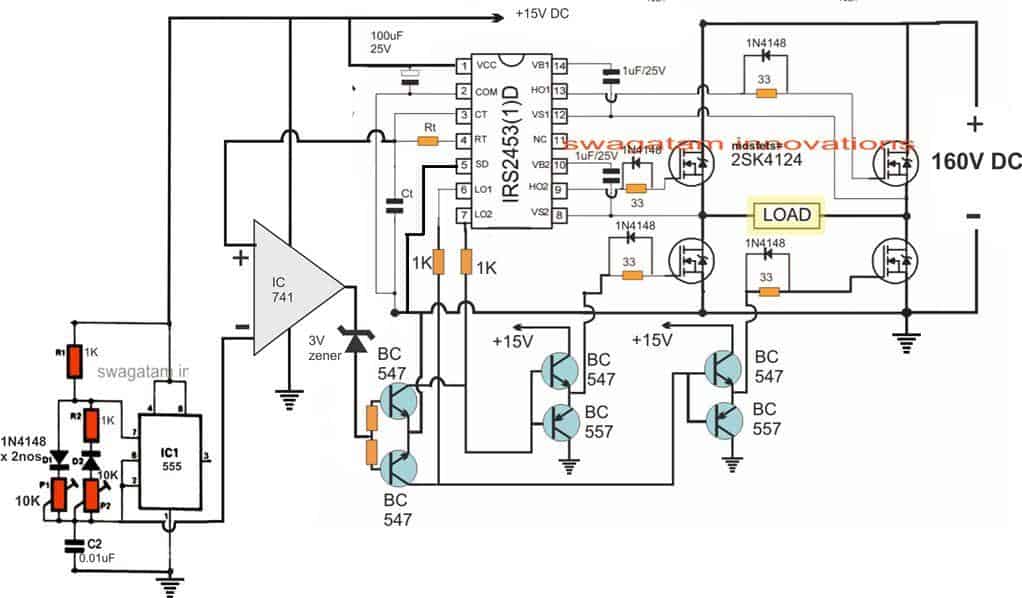
Bună dragul meu doresc să știu care este tensiunea de lucru în poarta tranzistorului Mosfet cît trebuie ca să lucreze 3v-5v -10v cevaloare este optimă casă nu se ardă tranzistorul am un montaj de invertor care se alimentează la tensiunea de 36v cam atît știu să explic mulțumesc .
The MOSFET gate voltage will keep varying according to the music level, from minimum to maximum supply voltage 60 V.
Since it is configured as a common drain amplifier, the gate source voltage will be always be between 7 and 10 V.
Sir, I am working on an H bridge sine wave inverter for 500W at 12V. I am able to convert the 12V DC battery to 12V AC at 50Hz doing open loop simulation. But when the load is connect the current is very low. How can I improve my power rating. Can you share reference material to design inverters with random power ratings at random voltages, like a generalised case.
Haizon, for 500 watt output, the current must be rated at 500 / 12 = 41 amps. Which means the battery must be rated at minimum 200 Ah capacity. So please simulate using a 12V 200 Ah battery
Sir how can we fix it as 200Ah. Can you please explain how to choose 200Ah.
Simulated using 200Ah battery Sir
Still the current at the output is 0.6A at 12V.
Simulation results are often not accurate, instead if you build and test your set up practically then I think you can accomplish the results correctly…
Manolis, yes you can use your mosfet amplifier for getting a pure sinewave AC output, by applying the input sine generator and 60V SMPS.
Sir, I have reead many article in electronic, and also from your site, and still yet am unable to start building circuit that are simple,
Pls sir how can I come over this challenges.
I will greatly appreciate your response sir.
Thanks in advance
It will take a lot of time and will require consistent reading and experimenting practically.
Hey swagatam ,pls I want to build auto battery charging cut off for my homemade inverter thanks in advance
How to wind the transformer for this inverter or which transformer can I use to make it
can you plz send me the clear circuit diagram of 1kv inverter
winding yourself is not required, you can buy it readymade by ordering a 0-9V / 50 amp / 220V transformer.
sir 50 amp or 5amp
divide 1000 by the battery voltage.
if your battery is 12v then 1000/12 = 84 amps, for 24V battery this will be 42 amps, for 48V battery this will be 21 amps.
the above are the current ranges for the transformer…the voltage of the transformer primary should be slightly lower than the battery voltage specs.
I’m much interested in learning electronics, can you help me EE
sure, if you have specific questions, you can ask them, I will try to answer…
Thanks you so much for your post and for sharing your knowledge.
I intend to build 3000 watt pure sine wave inverter with particular emphasis on pure sine wave aspect.
in my application i would like to have a circuit with a 230V output without any sine wave distraction.
Can you please give me some guide lines.
which of these drawings fits better, what changes will i have to make to have 3 kVA.
Thank so much for the help
Thanks, I think you should try the following concept which is more efficient than the above explained concept, since it works with SPWMs.:
https://www.homemade-circuits.com/1500-watt-pwm-sinewave-inverter-circuit/
thanks for your reply.
to better explain my application I intend make an AC power regeneration, meaning having the main 220V convert it to DC and then regenerate back to AC with low output impedance and proper 50Hz sine wave.
since I won’t need a battery maybe this project can be also transformerless?
if you could help me i would be very grateful
Then you won’t need a circuit? you can simply use two transformers, connect the low voltage sides with each other, and use one 220V side for feeding the mains input and the other 220V side to get the required low current 220V AC.
Hi. I just want to find out how I can calculate the Watt values of the 0.2R resistors in series of the sources of the mosfets in the sine wave inverter circuit. I am using 2 x 12 V batteries. So I’ll use a 24 transformer for primary, 220V secondary, but also 500VA, not 1kVa. This resistor Watt values are very important as the current flows through them,also causing a volt drop across it, and also to prevent thermal run away on the mosfets.
Can you please check my calculation in this regard
Va of transformer = 500VA
I through coil = 500VA/24V
= 20.833A
Now I thought that because I only want to work with the upper half of the wave form, I’ll divide that by 2, also because of duty cycle
So I saw that the current will be 10.416A
Now this resistors are in parallel, 2 of them with the same value, so to determine the current through one of the resistors I’ll have to divide by 2 again because it is the same in value. (Current divider)
So then I get a current of 5.208A
Now for this specific resistor (one of the 0,2R resistors), it is I*I*R
5.208*5.208*0.2
That gives me a value of 5.4W for each 0.2R resistor in the circuit.
Do you think this calculation done correctly
Thank you for you support in this regard
Hi, If you are not using two batteries then the average could be 10 amp, and the calculations appear to be correct.
Hello. Firstly, thank you. I need a minimum frequency of 4000 Hz in the part made with Arduino. I run this value via code. I get distorted signals at 4kHz on the oscilloscope on Proteus.
1-) What should I do in the code section to fix this?
2-) How many uF capacitors and how many ohms resistors should I use on the circuit, what else do I need?
Thank you again 🙂
From the wave forms,I don’t see a pure sine wave
The last circuit is a modified sine wave…the circuit with two op amp input will produce pure sine wave.
Pls how many MOSFET will you recommend for 2.5kva inverter
what is your battery voltage?
24voltage
two MOSFETs (IRF3205) on each channel will be enough (on heatsink)
Pls I don’t understand. Will 2pcs of irf3205 on each sink be OK to power 2.5kva 24v battery and it will not burn?
Sorry what you don’t understand? The ID and VDS rating of IRF3205 is 110 amps, so two will have 220 amps…and 220 x 24 = 5280 watts or 5kv capacity
And will the 2 irf3205 on each sink be able to charge back 200ah battery?
No, How can it charge back when it’s configured for inverter application?
So pls how can I configure the MOSFET to charge back the battery
you can perhaps try this:
https://www.homemade-circuits.com/single-transformer-inverterchargerchang/
Hello mr swagatam i really appreciate your good work by shearing your knowledge with us without charging any penny from us and god will blessed you and your entire family for being fruitful to the world. Please I have some question which is:
(1) In H bridge inverter modification from PWM to sine waveform why it’s that the external PWM or SPWM circuit output is alway fed only in low side Transistor not in or on the high side transistor
(2) why it’s that Zener diode is used in a circuit in reverse bias mode when linking another circuit to inverter shut down and is always 3v that you used
(3) please have you tested this pure sine wave inverter circuit because the sine wave generator is not self oscillating circuit thanks
Thanks Emmanuel,
1) the high side mosfet have complex bootstrap wiring across their gate source terminals which can get affected if PWM was added here, therefore only the low side MOSFETs are selected for this integration.
2) The zener diode makes sure that only the genuine gate switching voltage above a certain minimum level is allowed to reach the MOSFET, which avoids false triggering of the MOSFETs and possible shoot through.
3) I have tested it on smaller scale, and it worked perfectly. You can try any other sine oscillator from the net, if you are not able to make this oscillator circuit work. You can also try one of these oscillator designs:
https://www.homemade-circuits.com/phase-shift-oscillators-wien-bridge-buffered-quadrature-bubba/
Pls swag,I made one of your sg3524 for 24v using irf3205,though it works fine but the 3205 does get burnt every time.pls suggest to me what could be wrong and the best MOSFET to use and how to configure it best.
Hello Joseph, you may need to add reinforced protection to the circuit from the transformer reverse EMF spikes. Please add a 100 Ohm resistor, 12v zener, and capacitor buffer for the IC circuit from the 12V input supply, as done in this example circuit:
https://www.homemade-circuits.com/1500-watt-pwm-sinewave-inverter-circuit/
Your MOSFETs are OK…
Need clarification for following points:
1. In comment section it was mentioned that 50% of AH should be multiplied by battery volts to obtain power output. Does it mean that if we use 48 V battery, then output by this inverter configuration is 2400 W (2.4 kW).
2.Since dual supply is used, does it imply that though 2 batteries are used, for power output considerations only one battery is considered.
3. For backup time calculations, whether only one battery should be accounted for or 2
1) Actually the maximum power output from a battery should the ideal discharge rate multiplied with its voltage. For a lead acid battery it’s voltage multiplied by 1/10 or 1/5 of its Ah value. If this is not maintained the battery can deteriorate very quickly.
2) Yes according to me since it’s a full bridge system the output power should be equivalent of both the batteries combined.
3) for backup only two battery parameter should be considered since they work alternately.
can we multiply the mosfets by 3 yo obtain high power say 3000w?
yes you can….
sir , please can you give me a link where i can found 1000kva square wave inverter because the one i build from other site is not working. i have 12v 1000watt centre tap transformer and 230v as the output , 12v 62ah battery just a diagram that can fit my specification i just want to start with square wave, although i have came across some of your pure sine wave inverter but i want to start with square wave . i hope my request will be put into consideration . thanks
Youngking, you can use any square wave design, and modify it for getting 1kva output by appropriately upgrading its mosfets, transformer and battery for handling 1000 watts.
Good day Mr Swagatam, pls can you show how to fix a relay on1kva using sg3525 so that when light comes it wil be automatically charging the battery. God bles you sir.
Yusuf, you can use a simple relay driver stage using a transistor and a double contact relay, then connect the pair of center poles of the relay to the appliance, connect the pair of N/O contacts with the mains AC phase/neutral….and connect the pair of N/C contacts with the inverter mains phase/neutral.
for the relay driver stage connect the emitter of the transistor with negative supply of a 12V adapter connected with mains AC, positive of the relay with the positive of the adapter output, and the base also with the positive of the adapter…the base resistor can be calculated from the following article:
https://www.homemade-circuits.com/how-to-make-relay-driver-stage-in/
Hello friend, I am trying to make a 100W inverter with a 12V input to 120V output and was wondering what I need to change? Also, are there alternatives for the K1058 and J162 mosfets? Thanks!
Hi, you won’t have to change anything in the design expect the number of mosfet which can be limited to just one pair, meaning just one pair of mosfet will be enough to give you the required results.
You can use IRF540, IRF9540 mosfets
Just recently i purchased an old computer UPS and the transformer had 2 wires on the low voltage side. On the circuit board there was an heat sink with four mosfets attached of the same number.
Does it mean that this UPS provides a push pull effect to the 2-wire transformer connected using a full bridge circuit?
The UPS was operated from one battery.
yes it is using an H-bridge network for operating the two wire trafo in a push pull mode…
What is the advantage of using dual supplies with respect to GND in this inverter circuit. Does it affect the output AC waveform?
If we compare this circuit with other circuits in your blog that uses one battery to run an inverter, does it have any difference?
since it is an audio amp circuit, it had to use a dual supply, because originally the loud speaker had to be operated in a push pull mode.
When we are replacing the loud speaker with a trafo we are implementing the same concept, that is using a two wire trafo and achieving a push pull operation on it.
Whenever a two wire push pull trafo is used in an inverter, the supply has to be dual, or the circuit has to be an full bridge or H-bridge topology employing 4 mosfets in tandem.
if the above concept is to be avoided, a center-tap trafo will come into the picture
Dear Sir Swagatam,
Most people think circuit ground means negative pole of the battery. That is not true. I’ve seen many negative voltage regulators and can now understand that circuit GND and negative in certain cases can
not be the same.
When we say circuit Ground we refer to an electrical circuit where AC is involved.
In DC circuits there is nothing called ground but still people call that as negative terminal of battery.
This page shows the best example of a case where there is a separate positive and separate negative with respect to GND. The GND here is both positive and negative.
So people here need to be much more careful as to how they do their battery connection to the inverter in this circuit.
Let me first get this clarified from you.
THANKS
Hi Sherwin,
In circuits operating with dual supplies where a separate negative is involved with reference to a ground then this ground becomes different and a critical thing to observe, but in single supplies where there’s no separate negative with reference to a ground then the negative terminal itself is considered as the ground.
Therefore in DC circuits with single supply the negative is considered as ground which simply means a common zero voltage line.
Such parameters are a matter of understanding and the users must be aware of these facts.
SIR PLEASE EXAMPLE HOW CAN I DIMENSION THE MOSFET MAYBE FOR INSTANCE I HAVE A 1KVA TRANSFORMER WITH 12V 100AH BATTERY. NOW HOW DO I THEN KNOW HOW MANY MOSFET TO CASCADE PLS EXPLAIN
Christian, check the datasheet of the selected mosfet and find out the Vds(Drain-Source Voltage) and Id(Continuous Drain Current) specs of the mosfet, multiplying them will give you absolute max power or wattage of the mosfet. So you can use this data to calculate how many mosfets you may require to achieve the required inverter wattage output safely.
the above figures will be valid only when the mosfets are mounted on adequately large heatsinks.
HOW DO WE DETERMINE THE POWER OF AN INVERTER IS IT BY THE AMOUNT OF MOSFET USED OR BY THE TRANFORMER
Transformer and battery Ah.
according to the above specs you can dimension the mosfets
I av a square wave inverter using sg3524, pls help me with circuit Dat we convert it to sine wave
you can apply the following concept
https://www.homemade-circuits.com/2016/08/sg3525-pure-sinewave-inverter-circuit.html
Hello Sir, I’m still a student and I will do this circuit as my project. If I used 12V battery for this circuit, what will be the possible output?
Hello Liezl, you can multiply 12V with 50% of the AH rating of the battery that will give the max power of the inverter….
Hi, I think you can study the concepts explains in the following article and make the design accordingly for your specific application
https://www.homemade-circuits.com/2016/07/3-phase-induction-motor-speed.html
I don't trust simulators therefore i cannot suggest about simulators…because they will mostly give you incorrect/misleading results unless you are an expert and exactly know how to handle them..
Hello Swagatam I want to make a Sine pulse width modulation Inverter which can control the speed of induction motor ..Ihave the 12 V Dc i want it to particular ac for the rating of 1KVA inverter so plz will u guide me which circuit will be the perfect and will i have to simulate it first if yes then which circuit i shall simulate will u plz provide me that circuut
Hello Bhushan,
Hi, I think you can study the concepts explained in the following article and make the design accordingly for your specific application https://www.homemade-circuits.com/2016/07/3-phase-induction-motor-speed.html I don't trust simulators therefore i cannot suggest about simulators…because they will mostly give you incorrect/misleading results unless you are an expert and exactly know how to handle them.
this looks like an amplifier circuit, I was thinking about using a 12v battery but also I would have to build a circuit which can convert a single voltage dc supply into a high voltage dual polarity supply at 12v or even higher voltage. Do you think you can design such a circuit?
you can search for a BTL amplifier circuit or a bridge tied load amplifier and use it for your desired application
I want full 1KVA UPS circuit diagram for simulation
Hi Swatagam, how can this circuit be modified to work on higher voltage (380v dc) like ones found in dc-ac stage of pure sinewave inverter. Or I just have to use higher voltage transistors ? thanks !
Hi Rax, yes it's possible, if all the BJTs and the mosfets are rated to handle this voltage
the resistors will also need to be appropriately upgraded
Hi sir,
Thanks you so much for your post. But sir i want to make a drive circuit for my pulse transformer. the primary is only 10 turns. the output voltage is about 4kv. i have a sine wave input signal with frequency variable from 1khz to 100khz. So my question is can i use this circuit or which circuit is more suitable could you recomment? i'm waiting reply from you and thanks again.
You are welcome WM
you can use the same circuit which is shown in the above article, just make sure that the frequency is properly matched with the 10 turn primary and the core is a ferrite based material, otherwise the fets could instantly burn and get damaged
Hi veniyan, where do you get your 220V DC from? remember DC in high voltage is lethal and can kill you instantly with AC you still have a chance to get away but not with DC.
Hi Hitman, in your final diagram, you connect your sign wave direct to the input of the inverter circuit, now can you please tell me where the PWM of the sign wave is generated? As far as I know, the Mosfets are not analog devices, and can not handel the analog sign wave signal.
Chris, if you think mosfets cannot be used in analogue circuits then how are mosfets used in audio amplifiers??
the fact is mosfets can be used in digital as well as in analogue circuits, here the mosfets are connected as source follower meaning their sources will follow their gates in tandem…therefore if a sine wave is applied at their gates, then the output will be an exactly amplified sinewave.
here's an example simulation
http://www.falstad.com/circuit/e-mosfollower.html
Please work on the simulation of circuit simulation and testing of electronic circuits program file
Hi Swagatham,
Great resource.. I learned how inverter works, I actually needed some help, I bought an 1000 watt inverter couple of years ago, few days ago due to low voltage it started beeping, before i could turn it off I seen spark inside the inverter, I quickly switched it off.. Then after a while later I turned it on, from led panel everything was working fine, power flow remained continuous during AC on and battery mode or inverter circuit remained functional.. However with one exception the battery charging is not happening, I first thought my battery was totalled, I have had a seperate battery which I revived and put in to tickle charge for 12 hrs, put it back on and monitored it, the charge depleted after a day even it showed it was charging but upon checking it with multimeter on terminals I found out it's not feeding any flow to batt.. If I am not wrong is the spdt relay is gone?! Or the could be something else.. Please guide and help me out cause where I am we mostly face power outs.. If needed I can upload pics of internals of ups inverter…tha
Thanks DD, actually a low voltage should not have caused any problems, because at low voltage the net power gets reduced so overload or over-current cannot happen, so it looks little strange to me.
However from your analysis it appears that some part in the battery charging section has malfunctioned, you can track the wires which are responsible for carrying the voltage from the charger output to the battery, and check which part is causing this issue….prior to this confirm whether the battery charger is producing the required charging voltage or not, otherwise the issue could be in the charger controller stage.
yes the SPDT could be also responsible for this….you can replace it with a wire link to confirm the same.
My dear brother, I have a reflective capacity of 800 watts , but not enough to run my refrigerator 200 Watt and I want to increase their value to appropriate what is the solution?